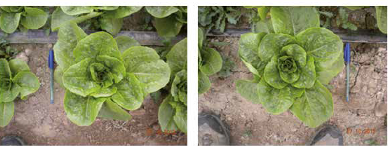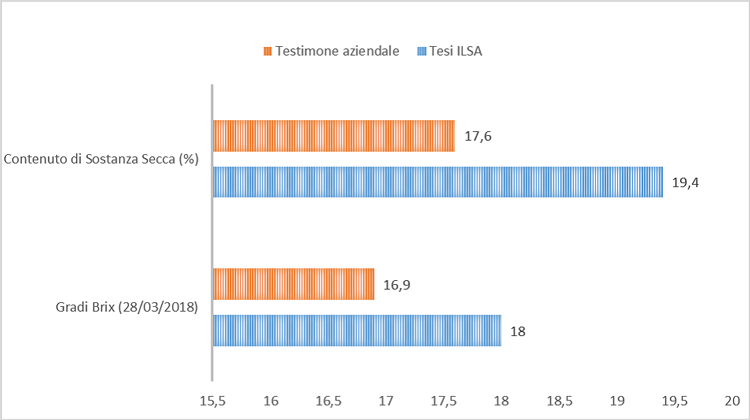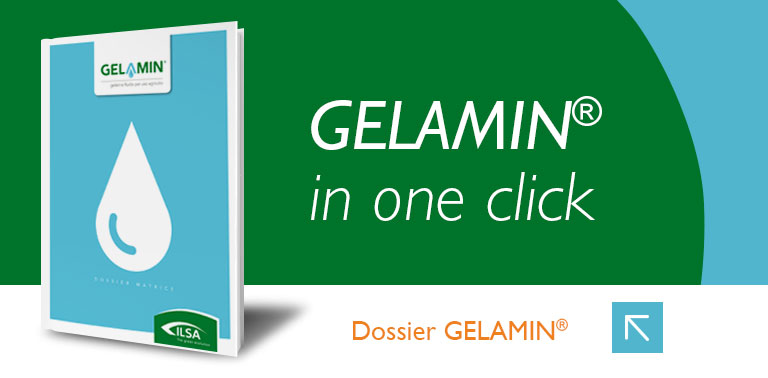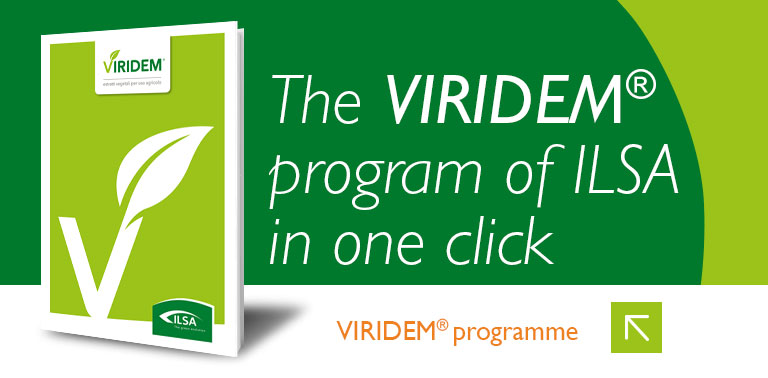Editorials
Salubrity and preservation of fruit and vegetable, how to extend shelf-life?
Ilsadurada and Siliforce have favored the increase of the preservability of lettuce and table grapes
30/08/2019
Fruit and vegetables, once detached from the plant, continue to breathe and ripe. In order to ensure that fruits like kiwis, apples, plums, peaches, apricots, bananas, tomatoes and other climacteric-defined fruits, have a post-harvest long life or the so-called shelf-life, they must consist of less water and more polymeric substances (i.e., vitamins, sugars, mineral salts, proteins, etc.). This prevents their rapid withering, more specifically, water favors the multiplication of microorganisms. This can be obtained by initiating the crop from a careful field fertilization technique. In fact, the use of products based on biologically active organic substances favors the formation of polymeric substances in the fruit during ripening, which serve to form a bond with the water and consequently increase the shelf life of the fruits.
Correspondingly, to obtain fruit and vegetables that can last long in sales counters, ILSA proposes Ilsadurada in association with Siliforce for leaf fertilization, and the administering should be done during the end of enlargement and beginning of the fruit ripening phase.
Ilsadurada is a biostimulant, which has been allowed in organic farming and its function is based on enzymatic hydrolyzate of Fabaceae. It allows to increase the shelf-life of fruit and vegetables thanks to a high concentration of natural triacontanol, vitamins (in particular B6) and specific bioactive organic compounds with intense antioxidant activity, such as aromatic polyketides and naringin derivatives, the polyphenolic acids and phenylpropanoids (i.e., gallic acid, chlorogenic acid, and caffeic acid). These compounds influence the secondary metabolism, thanks to the accumulation of antioxidants and the activity of the enzymes defended against oxidative stress (peroxidase, catalase), caused by free radicals.
Siliforce is an innovative organic fertilizer, which is based on ortho-silicic acid Si(OH) 4, Zinc and Molybdenum. These elements help plants to take advantage of the benefits of silicon in a stable and resistant to polymerization form. The ortho-silicic acid, compared to the traditional silicon, is derived from silicates rich in heavy metals, and is able to penetrate the plant cells. Transported by the sap, it condenses as a sort of colloidal gel, accumulating above all in the cells of the most superficial tissues of leaves, stems and fruits. This accumulation increases the thickening of plant tissues and reduces transpiration, with a consequent decrease in sodium absorption and aluminum fixation. It also favors an improvement in the qualitative aspects of fruits and vegetables in terms of consistency, concentration of solutes and dry substance, aspects of paramount importance for the healthiness and preservability of fruits.
The lettuce experience var. Green Romaine in Perù:
As shown in Table 1, on lettuce var. Green Romaine, Ilsadurada, applied to the dose 2 (kg / ha) every 7 days, starting from the 3 week before the cut, extended the goodness of the parameters evaluated by the producer up to 14 days, compared to the plants treated with traditional fertilization, which started much earlier to yellow and demonstrated a lesser 9-day commercial life in post-harvest.
 Figure 1: Visual comparison 07/10/2013 (10-days post-transplant)
Figure 1: Visual comparison 07/10/2013 (10-days post-transplant)
Green Romaine variety, right Thesis ILSA, left Corporate Thesis
GREEN ROMAINE (GR)
Evaluation date, in post-collection: 10/10/2013
Legend: 5 Very good - 4 Good - 3 Regular - 2 Bad - 1 Very bad
| Day | 1 | 4 | 6 | 8 | 9 | 11 | 13 | 14 | 15 |
|---|---|---|---|---|---|---|---|---|---|
| Corporate Thesis | |||||||||
| Freshness | 5 | 4 | 4 | 3 | 3 | 2 | - | - | - |
| Flavour | 5 | 4 | 4 | 4 | 3 | 3 | - | - | - |
| Odour | 5 | 4 | 4 | 4 | 3 | 3 | - | - | - |
| Appearance | 4 | 4 | 3 | 3 | 2 | 2 | - | - | - |
| Media | 5 | 4 | 4 | 4 | 3 | 3 | - | - | - |
| Thesis ILSA | |||||||||
| Freshness | 5 | 5 | 4 | 4 | 4 | 3 | 3 | 3 | 2 |
| Flavour | 5 | 5 | 5 | 4 | 4 | 3 | 3 | 3 | 3 |
| Odour | 5 | 5 | 5 | 4 | 4 | 3 | 3 | 3 | 3 |
| Appearance | 5 | 5 | 4 | 3 | 3 | 3 | 2 | 2 | 2 |
| Media | 5 | 5 | 5 | 4 | 4 | 3 | 3 | 3 | 3 |
Table 1: lettuce fertilized with the conventional practice demonstrated a lower life in post-harvest (9 days), compared to the same fertilized with ILSA biostimulants (14 days). The post-harvest conditioning, washing and classification process was carried out by Country Home S.A., based on the standards used in the company.
The experience on table grapes (Red Globe):
Agronomic tests carried out in 2018 in Chile confirmed the efficiency of Siliforce in improving the quality of table grapes destined for export. Siliforce was used in foliar application at a dose of 250 (cc / ha) for 6 times every 7 days, starting from the beginning of veraison.
Results:
The thesis in which Siliforce was applied, compared to the company thesis (treated plants with synthetic hormones), provided the best results both in terms of uniformity of table grape coloring 51.90% compared to 18.5% of the company thesis (Figure 3). But also in terms of sugar content with 18 °Bx compared to 16.9 as well as the dry substance at 19.4% compared to 17.6% of the untreated baton (Figure 1). Also the post-harvest conservation, evaluated as dry substance content and as resistance to fridge-preservation, registered better parameters from 33.3% to 66.7% of the ILSA thesis (Figure 2).

Figure 1: content in dry matter and ° Bx, Thesis ILSA blue stacked bars, Corporate Thesis orange stacked bars.
| Quality after 30 days cold-storage | ||
|---|---|---|
| Evaluation | Thesis ILSA | Corporate Thesis |
| Very good | 0,0 % | 0,0 % |
| Gooda | 0,0 % | 0,0 % |
| Regular | 66,7 % | 0,0 % |
| Poore | 33,3 % | 70,4 % |
| Very poor | 0,0 % | 29,6 % |
Figure 2: quality during cold storage.
| Uniformity of colouring during collection | ||
|---|---|---|
| Evaluation | Thesis ILSA | Corporate Thesis |
| RG1 | 51,90 % | 18,50 % |
| RG2 | 48,1 % | 51,9 % |
| RG3 | 0,0 % | 29,6 % |
| RG4 | 0,0 % | 0,0 % |
Figure 3: uniformity of colouring during collection.
Technical data sheets - Certifications - Dossier - Field results and other insights
-
Products
-
Crops
-
Gooseberry
Persimmon
Sorb
Fig
Pistachio
Hazelnut
Blackcurrant
Redcurrant
Raspberry
Walnut
Kiwi
Blackberry
Fruit Horticulture in greenhouse
Blueberry
Celery
Onion
Strawberry
Tomato in greenhouse
Carrot
Cauliflower
Asparagus
Beetroot
Fennel
Processing Tomato
Eggplant
Melon
Turnip
Leek
Courgette
Cucumber / Gherkin
Tomato
Watermelon
Melon in greenhouse
Ready-prepared vegetables
Pepper in greenhouse
Garlic / Scallion
Courgette in greenhouse
Strawberry in greenhouse
Pepper
Radish
Horticulture in greenhouse
Eggplant in greenhouse
Artichoke
Arugula
Lettuce in greenhouse
Chicory
Endive
Spring Cabbage
Savoy Cabbage
Turnip Tops
Spinach
Lettuce
Basil
Beet
Brussels sprouts
Parsley
Chicory





.png)
















